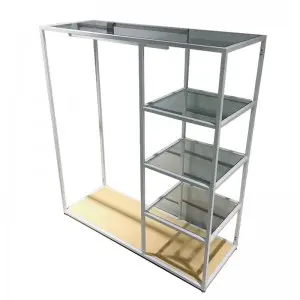Aug . 13, 2024 05:16 Back to list
Designing Effective and Modern Fixtures for Your Grocery Store to Enhance Customer Experience
Understanding Grocery Store Fixtures Enhancing Retail Experience
Grocery store fixtures are essential components of the retail environment, playing a critical role in the way products are displayed, organized, and sold. These fixtures not only serve functional purposes but also contribute significantly to the overall shopping experience. In this article, we will explore the various types of grocery store fixtures, their importance in retail design, and how they enhance customer engagement.
Types of Grocery Store Fixtures
Grocery store fixtures come in various forms, each tailored to specific needs within the store. Common types include shelving units, display cases, freezer and refrigerator units, checkout counters, and product stands.
1. Shelving Units These are perhaps the most recognizable fixtures in a grocery store. They can range from simple, adjustable metal shelves to more stylish wooden displays. Shelving units are designed to hold products at accessible heights, allowing customers to easily browse through items. The arrangement of these shelves can significantly affect product visibility and accessibility, influencing purchasing decisions.
2. Display Cases These fixtures are often used for high-end products or specialty items, such as cheeses, meats, or baked goods. Display cases can be refrigerated or non-refrigerated and are designed to showcase products attractively. The goal is to entice customers to make impulse purchases by presenting items in an appealing manner.
3. Refrigerated Units Essential for storing perishable goods, refrigerated fixtures maintain optimal temperatures for items like dairy, meat, and produce. These fixtures must be reliable and energy-efficient, as they contribute to both food safety and operational costs.
4. Checkout Counters The checkout area is a crucial part of any grocery store fixture layout. It is where the customer finalizes their purchase. Well-designed checkout counters should facilitate a smooth transaction while providing space for impulse buys, such as snacks and magazines, thus maximizing potential sales.
grocery store fixtures

5. Product Stands and Promotional Displays These fixtures are often used for seasonal items or promotions. Product stands can be strategically placed around the store to draw attention to new releases or sales, effectively guiding customer traffic and enhancing the shopping experience.
Importance of Grocery Store Fixtures
The design and arrangement of grocery store fixtures are vital for creating an efficient shopping environment. Good fixture design can improve product visibility, streamline customer flow, and enhance brand image. Effective use of space allows grocery stores to maximize their inventory while ensuring that customers can find what they need quickly.
Additionally, grocery store fixtures can influence customer behavior. For example, placing items at eye level tends to increase sales as customers are more likely to notice and purchase items that they can easily see. Similarly, creating inviting displays can encourage customers to try new products, thus expanding their shopping experience beyond regular purchases.
The Role of Technology
In recent years, technology has started to play a more significant role in grocery store fixtures. Digital displays, smart shelves with sensors, and interactive kiosks are becoming increasingly common. These innovations not only engage customers but also provide valuable data to retailers about shopping patterns and preferences.
Conclusion
In conclusion, grocery store fixtures are much more than mere shelving and display units; they are integral to the retail experience. By understanding the various types of fixtures available and their impact on customer behavior, grocery store owners can create inviting and efficient shopping environments that drive sales and enhance customer satisfaction. As technology continues to evolve, the potential for innovative grocery store fixtures will only expand, ensuring that the future of grocery retail remains dynamic and engaging.
-
The Benefits of Electronic Shelf Labels for Modern Stores
NewsJul.01,2025
-
Space-Saving Retail Store Furniture Designs for Small Shops
NewsJul.01,2025
-
Slatwall vs. Gridwall: Which Store Fixture is Right for Your Business?
NewsJul.01,2025
-
Shop Fittings: Essential Elements for a Functional Retail Space
NewsJul.01,2025
-
How to Design a Minimalist Cosmetic Shop Display
NewsJul.01,2025
-
Creative Clothes Shop Display Ideas to Attract More Customers
NewsJul.01,2025


















































































































